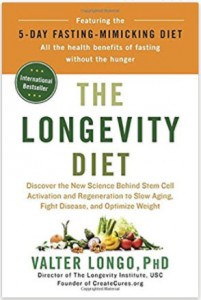Rejuvenate with Fasting-Mimicking Diet

LOS ANGELES, Calif (January 23, 2018) –The term “Fasting-Mimicking Diet” is being seen more often these days. Science Daily published a story on the results of a clinical trial here. The Wall Street Journal wrote about the diet in April 2017, and Forbes Magazine wrote about it in February of 2017.
It has been gaining popularity in recent years because it seems to turn on genes that fight aging. Its creator, Dr. Valter Longo, the Director of University of Southern California’s Longevity Institute, created it in 1997 when he joined USC. This diet restricts your food intake to between 750 and 1,100 calories per day for a stretch of five consecutive days. Participants eat plant-based soups, crackers, olives, energy bars, herbal teas and supplements developed by Longo in conjunction with the company L-Nutra to be high in unsaturated fats, but low in carbohydrates and protein.
Patients who adhered to it for only three months have seen multi-system rejuvenation, lower inflammation, lower blood pressure, increased production of stem cells, and reductions in body fat and waist size. Some participants saw blood glucose levels and total cholesterol drop, too. Side effects of following the diet included mild fatigue, headaches, and weakness. Those symptoms, however, decreased each month for most people with each cycle of the diet.
So why does it work? It seems that fasting triggers our cells to conserve energy so that we can survive a period of limited food. In the distant past lack of available food could have been caused by droughts or other natural disasters that destroyed food supplies. Not to mention, food was much scarcer in winter for most populations around the globe. Today, calories are readily available in any season to most everyone living in a first-world country. Fasting is rarer in modern times than it ever has been in the past.
Because our cells are trying to conserve energy when food is scarce, calorie restriction leads to increased cellular maintenance and protection, removal and replacement of damaged cells, and a reduction of inflammation. In mice, fasting-mimicking diets improve cognitive performance. Even after participants were taken off the diet, the positive effects remained for many months.
 Of course, pure fasting with zero calories has health benefits, too. And it results in weight loss which comes with its own set of benefits. But this diet seems to be better than pure fasting because participants have the satisfaction of eating something. They are also getting micronutrients like vitamins and minerals that they wouldn’t get by avoiding food altogether. (Diabetics, however, should not try this diet as it could cause severe problems for them.) So, your stomach sees food and your cells see fasting. For many people, this could be an achievable way of engaging in the very healthy practice of calorie restriction.
Of course, pure fasting with zero calories has health benefits, too. And it results in weight loss which comes with its own set of benefits. But this diet seems to be better than pure fasting because participants have the satisfaction of eating something. They are also getting micronutrients like vitamins and minerals that they wouldn’t get by avoiding food altogether. (Diabetics, however, should not try this diet as it could cause severe problems for them.) So, your stomach sees food and your cells see fasting. For many people, this could be an achievable way of engaging in the very healthy practice of calorie restriction.
Dr. Longo’s book, The Longevity Diet: Discover the New Science Behind Stem Cell Activation and Regeneration to Slow Aging, Fight Disease, and Optimize Weight, was released this month. It’s the culmination of 25 years of research on aging, nutrition, and disease across the globe, and his unique program lays out a simple solution to living to a healthy old age through nutrition.

